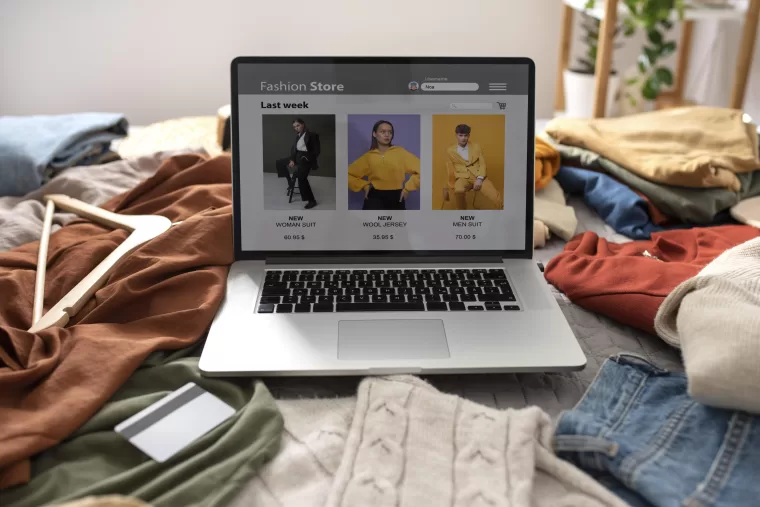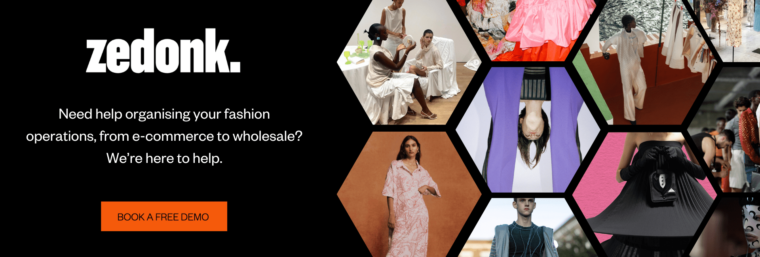For years, luxury fashion brands have been synonymous with exclusivity, opulence, and the experience of having products highly customised. However, rapid digitalisation in retailing and other unforeseen challenges caused by the COVID-19 pandemic and the changing economy are making luxury brands rethink their e-commerce strategies. With the recent spate of luxury online fashion brands reporting record losses and the downfall of shops like MatchesFashion, Net-A-Porter and Farfetch, the future of luxury e-commerce is uncertain. In this article we take a look at what is influencing the implosion in luxury e-commerce, how it is affecting the rest of the industry and what role a robust fashion ERP system can play in streamlining and managing e-commerce.

The Implosion in Luxury E-Commerce
Luxury brands’ e-commerce has been on quite a rollercoaster over the past few years. The sector initially boomed as luxury brands rushed to establish an online presence. However, more suddenly than expected, the implosion in luxury e-commerce took effect. The high demand for convenience and customisation, coupled with rapid global infrastructure improvements, led to this initial boom – but ironically has also contributed to the crash.
Challenges of Porting the In-Store Experience Online
One of the critical challenges luxury brands face in the online environment is rendering the exclusive one-of-a-kind in-store experience within the digital space. The tactility of a luxury product, together with the personalised service provided and a high-end boutique ambience, remains to be achieved online. Consequently, this created a challenge in not losing brand integrity and customer loyalty in the digital domain. This demands additional work for luxury brands in the digital space to continually sustain their image and loyalty. The cluttered digital marketplace requires a luxury brand to find ways of standing out with online marketing strategies that are consistent and engaging.
Inventory and Supply Chain Management
Another big issue that businesses based on luxury brands’ e-commerce face is inefficiency in the supply chain, paired with overproduction. Brands must wield tight inventory control to not create an overstock position that results in discounting and dilution of the brand. This has led to over-saturation and increased competition, putting pressure on profit margins. With the uniqueness that made luxury brands distinguishable from the rest fading as more get into e-commerce, it has seemingly created a race towards the bottom with prices and promotions that may devalue luxury brands in the long term. Adding to this is the proliferation of copycat brands and cheaper fast fashion platforms.
Since the Covid-19 pandemic, supply chains worldwide have had to adapt, weather storms, and reintegrate into the economy again, Free places saw as big an impact as the fashion industry, which is run by many complex and interlocked supply chains, which are in turn also affected by supply and demand.
Adapting to technology is also how these challenges can be addressed, for example, through a robust ERP (Enterprise Resource Planning) solution. Real-time information about product levels will increase the efficiency in managing production and inventory properly. Furthermore, an ERP system can also help streamline the operation of the supply chain to ensure that the needed products are available when and where they are required.
The Impact Of COVID-19 On The Online Luxury Fashion Industry
The global pandemic dramatically accelerated a shift toward e-commerce in the luxury fashion retail sector. Most high-end brands rushed to pivot strategies to an improved digital presence and online shopping experience amidst lockdowns and social distancing measures. At the same time, the first surge of online shopping during the pandemic raised optimism among luxury e-commerce businesses. Many players in this field have faced numerous problems, from supply chain disruptions to inventory management, to maintain their premium image in a purely digital environment.
The pandemic pushed luxury brands to shut down their physical stores and move reliance to e-commerce. It came as an overnight decision and online readiness was shown to be flawed for many brands. The lockdown and subsequent social distancing efforts have drastically increased the rate of online shopping. If this created sales in e-commerce, then it made the competition even more fierce, which has again put pressure on brands to enhance their digital offerings even more.

Adapting to the New Normal
Reputed luxury brands have adopted different strategies to adjust to the new normal; for instance, they created virtual showrooms, intensified digital experiences, and further enhanced online customer service. Here are some of the strategies luxury brands have implemented to adapt to the new normal:
- Virtual Showrooms and AR Experiences: To bring the in-store vibe to life.
- Stepped-up Digital Marketing: To keep the brand visibly active and engaging.
- Better Logistics and Delivery Services: To ensure a premium experience from the point of buying to picking up.
A luxury brand can thus quickly adapt to the new behaviour and, simultaneously, quite efficiently scale online operations with an e-commerce-enabled ERP system. The incorporated ERP allows rapid responses to changes in the market while maintaining excellence in customer service through a consolidated platform for physical and digital operations.
The Impact of MatchesFashion and Lessons Learned
In this respect, the recent troubles faced by the once-darling-of-the-luxury e-commerce world MatchesFashion should serve as a cautionary tale, particularly to the brands that rely on e-commerce retailers for their wholesale. The company rapidly expanded – coupled with supply chain issues and changing consumer preferences – before entering into massive financial difficulties that ultimately resulted in its acquisition by Frasers Group. Initially valued at approximately 800 million pounds, it is now being bought for less than 100 million, with previous stakeholders and customers alike losing money.
Why Did MatchesFashion Collapse?
Over-expansion: The aggressive strategy for growth increased the company’s operational costs but did not lead to a corresponding increase in revenue.
Inventory Management Problems: Poor stock control paved the way for overstock and, hence, markdowns, which eroded profit margins.
Changing Consumer Behaviour: The company was not ready for the paradigm change in shopping behaviour after the pandemic.
The MatchesFashion story reinforces the need for agility, adaptability, and customer-centricity to ride out market fluctuation tides in the luxury e-commerce landscape. It also further emphasises robust inventory management, strategic partnerships, diversified revenue streams, and the importance for fashion brands to have their own e-commerce channels separate from online retailers.
Strategies for Designers to Minimise the Impact
Considering the present adversities of luxury e-commerce, designers and luxury brands need to find creative ways through which they are going to survive within the business. Here are a few key strategies:
- Leverage Data-Driven Insights: Through advanced analytics with the help of consumer data, companies can look at market trends, allowing them to tailor their offerings – an ERP system can provide optimisation in production and help make more informed decisions.
- Omnichannel Experiences: Fuse online with offline to provide an experience that genuinely carries a powerful brand image consistently. An ERP system can support this union because it correlates the back-office functions with the customer-facing operations.
- Add a Human Touch: Deploy AI-powered chatbots and virtual stylists to assist online customers, but with a human overseeing it.
- Digital Marketing Innovations: Test something new, like engaging influencers for co-brand partnerships, virtual fashion shows and showrooms, and social media interaction to engage customers.
- Focus on Exclusivity: Make sure the brand stays desirable through its controlled release of limited editions, collaborations, and online events exclusively.
- Sustainability: Let your brand communicate its commitment to ethical and sustainable practices; this is one needed trend today that more and more luxury consumers are noting. ERPs like Zedonk can help with this by giving you a clear view on your consumption and how much you need to make your products, reducing waste.
- Invest in Technology: Bring AR and VR technologies for an enriched online shopping experience to bridge the gap between the virtual and brick-and-mortar marketplace.
- Supply Chain Optimisation: Use ERP systems to optimise visibility in the supply chain, reduce lead time, and enhance overall operational efficiency.
In this way luxury brands can use these strategies and advanced technologies like ERP systems, to navigate the current e-commerce crisis and position themselves for long-term success in the digital landscape.

The Future Of Luxury E-commerce
The luxury e-commerce space is undoubtedly fraught with challenges; from replicating the very experience of in-store to keeping pace with increasingly fast-changing consumer behaviours. The trouble with luxury e-commerce may be foundational, but it is also fixable. With these challenges comes an opportunity for innovation and growth. By learning from past mistakes, adopting technological solutions, such as fashion ERP software, and strategies putting the customer in their core operations, luxury brands will be able to flourish and not only survive in an e-commerce world.
It’s all about balance, protecting brand exclusivity on one side and meeting the expectations of digital-savvy luxury consumers on the other hand. Only the brands that successfully blend traditional allure with e-commerce convenience and reach will be best suited to prevail in this evolving industry, working through present troubles to remake the future of luxury retail.
To learn more about Zedonk’s erp for the fashion industry and how they can benefit your brand, book a demo with on of our experts and find out how they can guide your e-commerce site towards a more secure and productive future.



 A New Sampling & Tech Pack Solution from Zedonk.
A New Sampling & Tech Pack Solution from Zedonk.